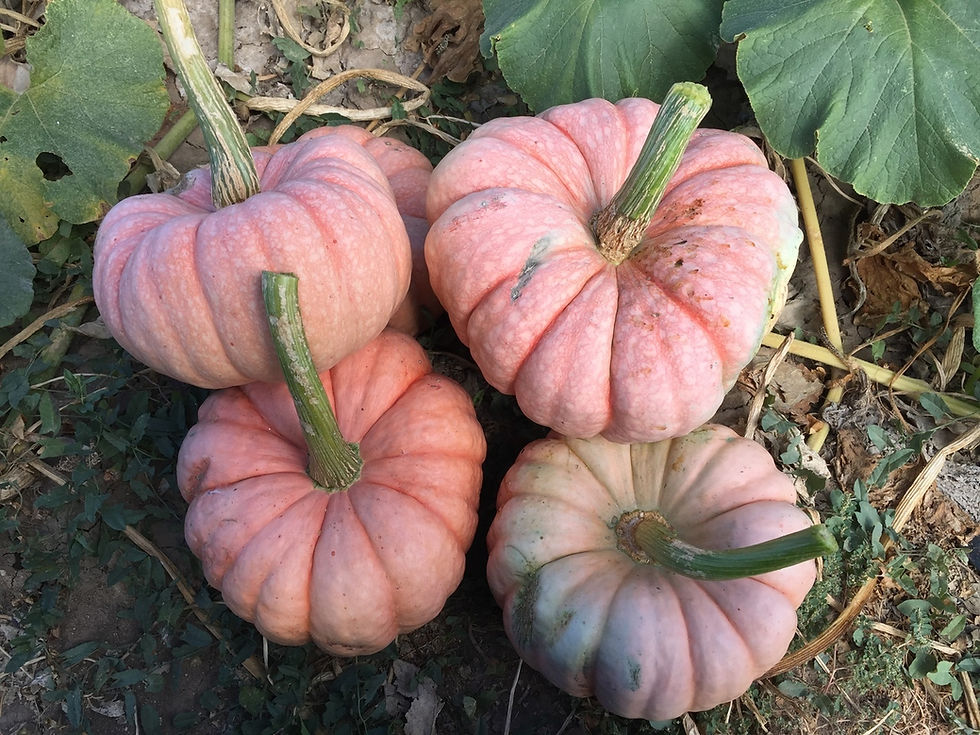Pumpkins! All the Varieties I Grow & How to Use Them
- Petals Bouder

- Nov 11, 2020
- 3 min read

Pumpkins were my gateway plant. The very first thing I ever grew in my garden and probably still my favorite thing to grow--with dahlias a close second. When I get my farm it'll be SO fields of pumpkins and rows and rows of dahlias! Pumpkins come in a staggering variety of colors, flavors, and textures. Here I will detail a few of the varieties we grow and how we use them! I have provided links to where you can buy seeds, these links do not benefit me in any way but are simply suggestions on environmentally sound places to buy your seeds (remember: Monsanto now owns Burpee- yikes!)
Blue Pumpkins

1. Jarrahdale - The "Blue" Pumpkin
This heirloom pumpkin is native to australia and is a cross between a blue hubbard pumpkin and the cinderella pumpkin. Its flesh is dense and not at all water like traditional pumpkins. When you cut into it (which is VERY difficult), it emits a lovely, floral smell. When roasted, the puree is some of the creamiest you can get from a pumpkins. When properly cured (let to sit in the sun about 15 days after harvesting), they can be stored in a cool dark space for up to 12 months! I use this pumpkin in anything that call for pumpkin or squash--from pumpkin breads to soups. One half of one of these will give you about 4 cups of pumpkin puree.
Pink Pumpkins

The Porcelain Doll Pink Pumpkin and her smaller sister Porcelain Princess are hybrid pumpkins developed in 2011 to raise money for breast cancer research (how awesome is that?!?!) Not only are these pumpkins show stoppers, their flesh is similar to that of the Jarrahdale and can be used in the same way. Also like the Jarrahdale, pink pumpkins are tough to cut into, but so so worth it.
Cinderella Pumpkins

The cinderella pumpkin - or Rouge Vif D'Etampe (I'm on the fence as to which name is more amazing) really lives up to its name and the pictures simply do not do it justice. These old French varieties had their heyday in French markets in the 1800s but are growing in popularity again. Their flesh can be used interchangeably in the same ways as the porcelain doll and jarrahdale but these grow much much bigger and are SO satisfying to grow (On averrage I get up to 20 cups of puree from just one). They are also easier to cut into than the blue and pink varieties. Need more reasons to grow these beauties? They have a days to maturity of just 100 days so work even in Northern gardens. They are pretty resistant to powdery mildew (which effect only the vine anyway), and are not overly trailing so you can generally grow them in smaller gardens). Remember, pumpkins LOVE radiant heat so place them next to a stone walkway, or garden rocks. Companion planting with nasturtium can help reduce pests and bring pollinators with with their flowers, and look pretty, and nasturtium (flower and all) and also edible.
Pie Pumpkins

Sugar baby, baby pam, autumn gold, and lumina (its white so perfect for making a Jack Skellington decoration!) are all marketed as pie pumpkins. I tend to grow sugar babies and lumina as I like the looks of them and they are petite but I also use my fancy pumpkins above for baking and soups so these more generic pie pumpkins aren't really necessary in my garden unless they are interesting to look at--I'm looking at you lumina. Just don't use your jack o'lantern pumpkin for puree unless you have to, those pumpkins are edible but tend to be too watery and stringy to get the best results. If growing lumina, harvest them in late August or early September as cold stress can cause the pumpkins to get an unearthly blue tint (unless you're into that's sort of thing!)
Ornamental Pumpkins
For floral design, cuteness overload, and simply because they make me smile, I grow miniature pumpkins Jack-Be-Little and Little Boo. These tiny pumpkins tend to grow in a more mounding plant than the long vines of the big boys above and can, therefore, be grown in smaller spaces.
And for something really show stopping....PUMPKIN ON A STICK!
These are actually Japanese Eggplant. They are super easy to grow and can be grown in a container and make awesome additions to floral design or as stand alone elements in your fall decor.
















Comments